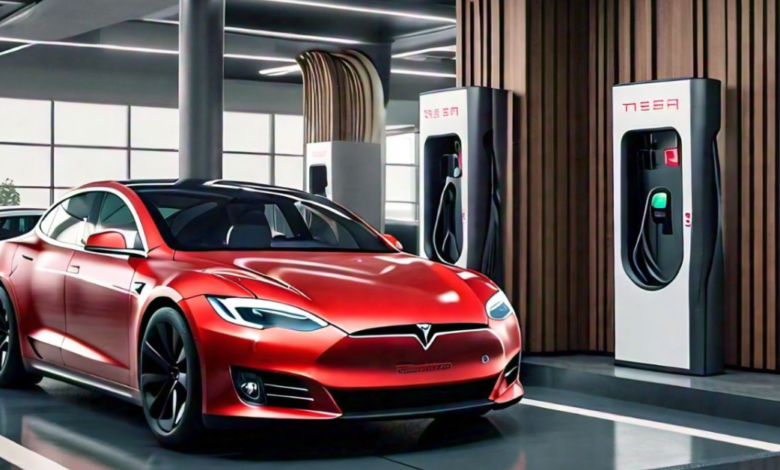The Ultimate Guide to Charging Your Tesla: Home vs. Supercharger

When it comes to electric vehicles (EVs), Tesla leads the way with its robust network of Superchargers and efficient home charging solutions. Understanding how long it takes to charge a Tesla is crucial for planning road trips and daily commutes. This guide breaks down everything you need to know about charging your Tesla, whether you’re at home or on the go.
Charging at Tesla Superchargers
What are Superchargers?
Tesla Superchargers are the fastest way to recharge your Tesla on the road. These high-speed chargers can provide a significant range boost in a short time, making long trips more feasible with an EV. As of 2024, Tesla’s network spans thousands of locations across North America, ensuring that you’re never too far from a quick charge.
How Fast Are Superchargers?
Charging times at Superchargers can vary based on several factors, including the specific Tesla model, the Supercharger’s speed, and the battery’s current state. Generally, a good rule of thumb is that you can charge from 20% to 80% battery capacity to save electricity in less than 30 minutes. For example, at a 250 kW Supercharger, you might add 150 to 200 miles of range in under 30 minutes.
Factors Influencing Charging Speed
- Battery Preconditioning: If you use Tesla’s onboard navigation to direct you to a Supercharger, the car will automatically start preconditioning the battery, optimizing it to accept a charge at a high speed upon arrival.
- Battery State of Charge: Charging speeds slow down as the battery fills up. For this reason, Tesla recommends stopping at 80% during road trips unless the full range is necessary. Charging from 90% to 100% can take much longer, often more than an hour, due to the decreased charging rate at higher capacities.
- Supercharger Type: Tesla’s V3 and V4 Superchargers can deliver up to 250 kW, significantly faster than older V2 Superchargers, which max out at 150 kW.
- Operating Conditions: The performance of Superchargers can be affected by peak demand times and extreme temperatures, both of which can slow down charging speeds.
Real-World Charging Experiences
Many Tesla owners share their experiences on platforms like Reddit, providing insights into what you can expect in real-world conditions. For instance, in MotorTrend testing, a Tesla Model S Plaid took about 51 minutes to charge from 5% to 95% using a V3 Supercharger with a preconditioned battery.
Home Charging Solutions
Level 2 Home Chargers
Most Tesla owners do the majority of their charging at home using a Level 2 charger. These chargers provide a significant amount of range per hour and are a convenient solution for overnight charging.
Speed and Installation
A Level 2 charger typically adds between 25 to 40 miles of range per hour, allowing a full recharge overnight. Tesla’s Wall Connector, for example, can deliver up to 11.5 kW, which equates to about 48 amps. This is sufficient for most Tesla models, though lower-end variants charge at 7.6 kW (32 amps).
Home chargers usually require professional installation, similar to large household appliances like stoves or water heaters. Alternatively, you can use a charger that plugs into an outlet, offering up to 9.6 kW (40 amps), the maximum allowed by code for non-hardwired devices.
Level 1 Charging
For those who don’t drive long distances daily, a standard 120-volt outlet (Level 1 charging) can be sufficient. This method is much slower, adding around 3-4 miles of range per hour, and may take several days to fully recharge a battery. However, it can be practical if you only need to top up your Tesla occasionally.
The Benefits of Combining Solar Power
Pairing your Tesla with a home solar power system can significantly reduce your energy costs. Solar panels generate electricity that can be used to charge your EV, providing a source of clean, renewable energy. Over time, the savings on electricity can offset the initial investment in solar panels. According to the EnergySage Solar Marketplace, most homeowners break even on their solar investment within about seven and a half years, and the panels continue to produce electricity for over 25 years.
Choosing the Right Charging Solution
Your charging needs will depend on your lifestyle and driving habits. Superchargers are ideal for long trips, providing fast, convenient recharges. For daily use, a Level 2 home charger offers a practical and efficient solution, ensuring your Tesla is always ready to go in the morning. And if you’re looking to reduce your environmental impact and energy costs, integrating solar power can be a great option.
Understanding the ins and outs of Tesla is the target of some high-tech charging can help you make the most of your electric vehicle, whether you’re planning a cross-country adventure or just your daily commute.



